
Operation Gauntlet was an Allied Combined Operation from 25 August until 3 September 1941, during the Second World War. Canadian, British and Free Norwegian Forces landed on the Norwegian island of Spitsbergen in the Svalbard Archipelago, 650 mi (1,050 km) south of the North Pole.

The Blohm & Voss BV 222 Wiking was a large, six-engined German flying boat of World War II. Originally designed as a commercial transport, it was the largest seaplane to attain production status during the war.

The German Air Force is the aerial warfare branch of the Bundeswehr, the armed forces of Germany. The German Air Force was founded in 1956 during the era of the Cold War as the aerial warfare branch of the armed forces of then West Germany. After the reunification of West and East Germany in 1990, it integrated parts of the air force of the former German Democratic Republic, which itself had been founded in 1956 as part of the National People's Army. There is no organizational continuity between the current German Air Force and the former Luftwaffe of the Wehrmacht founded in 1935, which was completely disbanded in 1945/46 after World War II. The term Luftwaffe that is used for both the historic and the current German air force is the German-language generic designation of any air force.

Hans-Joachim Marseille was a German Luftwaffe fighter pilot and flying ace during World War II. He is noted for his aerial battles during the North African Campaign and his Bohemian lifestyle. One of the most successful fighter pilots, he was nicknamed the "Star of Africa". Marseille claimed all but seven of his 158 victories against the British Commonwealth's Desert Air Force over North Africa, flying the Messerschmitt Bf 109 fighter for his entire combat career. No other pilot claimed as many Western Allied aircraft as Marseille.

Between 1933 and 1945, the organization of the Luftwaffe underwent several changes. Originally, the German military high command, for their air warfare forces, decided to use an organizational structure similar to the army and navy, treating the aviation branch as a strategic weapon of war. Later on, during the period of rapid rearmament, the Luftwaffe was organized more in a geographical fashion.
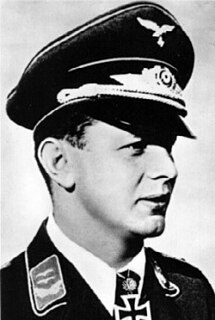
Josef "Pips" Priller was a German military aviator and wing commander in the Luftwaffe during World War II. As a fighter ace, he was credited with 101 enemy aircraft shot down in 307 combat missions. All of his victories were claimed over the Western Front, including 11 four-engine bombers and at least 68 Supermarine Spitfire fighters.

Royal Air Force St. Eval or RAF St. Eval was a Royal Air Force station for the RAF Coastal Command, southwest of Padstow in Cornwall, England, UK. St Eval's primary role was to provide anti-submarine and anti-shipping patrols off the south west coast. Aircraft from the airfield were also used for photographic reconnaissance missions, meteorological flights, convoy patrols, air-sea rescue missions and protection of the airfield from the Luftwaffe.

Hans Peter Waldmann was a German Luftwaffe fighter ace and recipient of the Knight's Cross of the Iron Cross of Nazi Germany. Waldmann received the award after he had shot down 85 enemy aircraft. In total, he was credited with 134 aerial victories accumulated in 527 combat missions.

Kurt "Kuddel" Ubben was a German Luftwaffe wing commander and military aviator during World War II, a fighter ace listed with 110 aerial victories—that is, 110 aerial combat encounters resulting in the destruction of the enemy aircraft—claimed in approximately 500 combat missions.
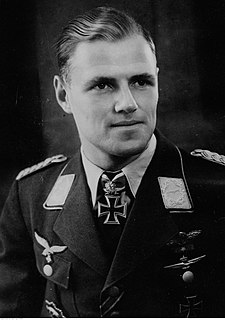
Joachim Müncheberg was a German Luftwaffe fighter pilot during World War II and an ace credited with 135 air victories. The majority of his victories were claimed over the Western Front, with 33 claims over the Eastern Front. Of his 102 aerial victories achieved over the Western Allies, 46 were against Supermarine Spitfire fighters.
Zirkus Rosarius was an Erprobungskommando-style special test unit of the Luftwaffe, specifically of the Luftwaffe High Command, tasked with testing captured British and American aircraft, all of which were repainted in German markings.
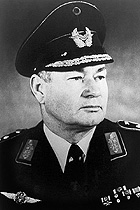
Friedrich-Erich Obleser was a German general in the Bundeswehr. During World War II, he served as a fighter pilot in the Luftwaffe. A fighter ace, Obleser was credited with 120 aerial victories and was a recipient of the Knight's Cross of the Iron Cross, the highest award in the military and paramilitary forces of Nazi Germany during World War II. For his post-war service in the German Air Force, he received the Grand Cross with Star of the Order of Merit of the Federal Republic of Germany.

Otto Schulz was a German Luftwaffe military aviator and fighter ace in World War II. He is credited with 51 aerial victories claimed in over 450 combat missions whilst flying the Messerschmitt Bf 109. He claimed 48 aerial victories against the Western Allies and three over the Eastern Front.
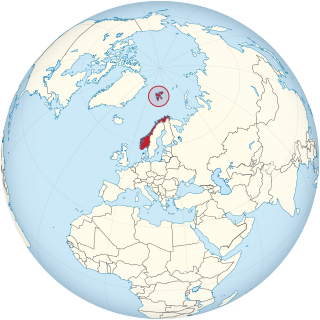
Operation Fritham was an Allied military operation during the Second World War to secure the coal mines on Spitsbergen, the main island of the Svalbard Archipelago, 650 mi (1,050 km) from the North Pole and about the same distance from Norway. The operation was intended to deny the islands to Nazi Germany.
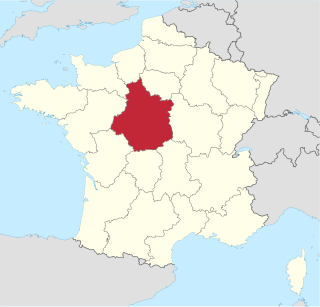
Chartres – Champhol Aerodrome is an airport serving Chartres and Champhol, in the Eure-et-Loir department in north-central France. The airport is located 2.5 km (1.3 NM) east-northeast of Chartres and it is southeast of Champhol. It supports general aviation with no commercial airline service scheduled.
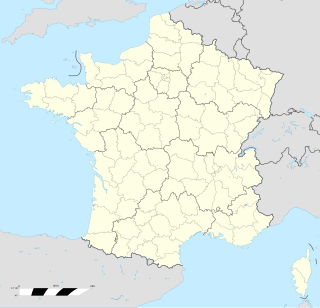
Vitry-en-Artois Airfield is a regional airfield in France, located 1 mile (1.6 km) northeast of Vitry-en-Artois; 105 miles (169 km) north-northeast of Paris. It supports general aviation with no commercial airline service scheduled.
Leo Gburek was a German geophysicist and a member of the Third German Antarctic Expedition 1938/39.

Operation Gearbox was a joint Norwegian and British operation to occupy the Arctic island of Spitzbergen during the Second World War. It superseded Operation Fritham, an expedition in May, to secure the coal mines on Spitsbergen, the main island of the Svalbard Archipelago which had failed when attacked by four German Focke-Wulf Fw 200 Condor reconnaissance bombers. The Norwegian force, with 116 long tons (118 t) of supplies, arrived by British cruiser on 2 July.

Operation Gearbox II was a Norwegian and British operation during the Second World War on the Arctic island of Spitzbergen in the Svalbard Archipelago. Operation Fritham, the first attempt to establish a base had been defeated when the two ships carrying the force were sunk by Luftwaffe bombers on 14 May.
![]() _A where _ is replaced by the identification letter of the individual aircraft
_A where _ is replaced by the identification letter of the individual aircraft













